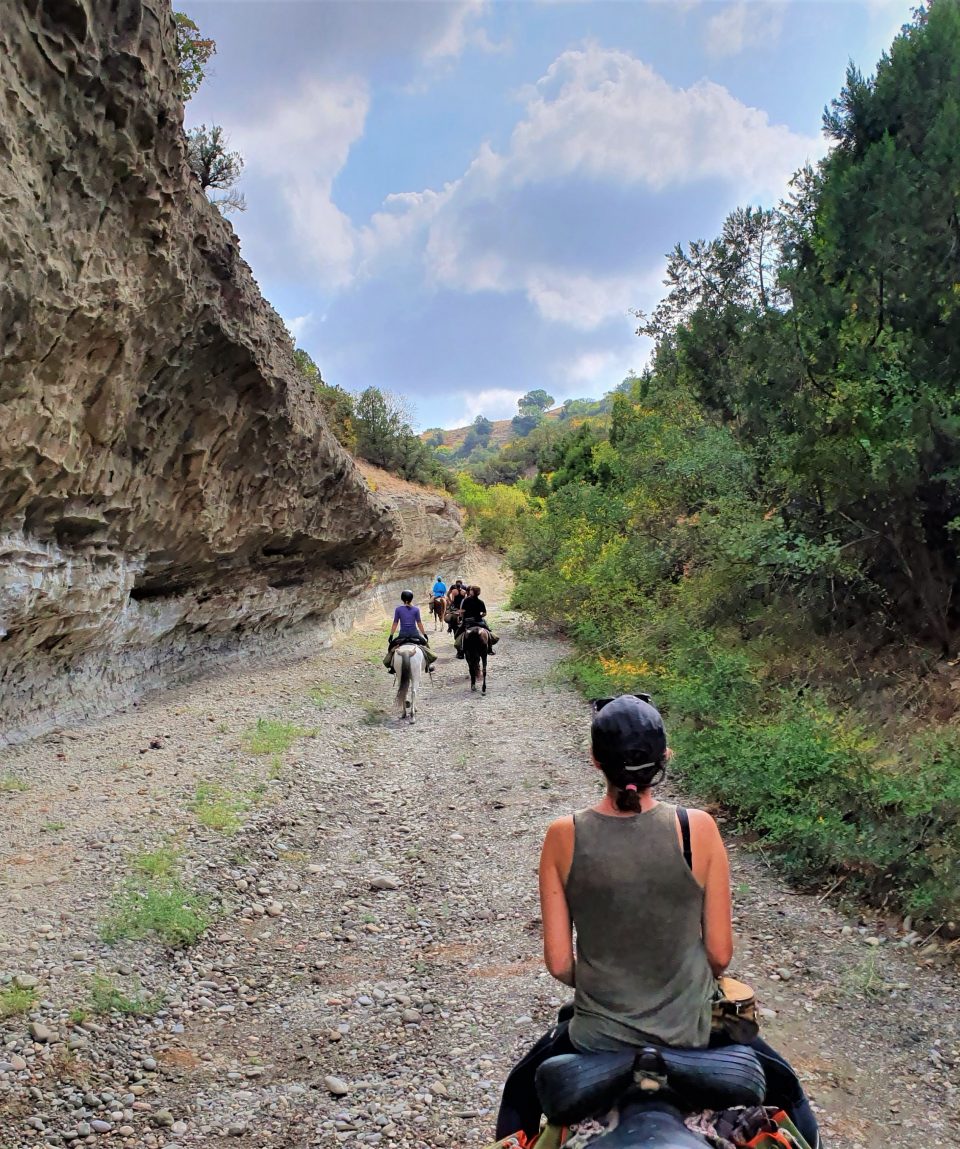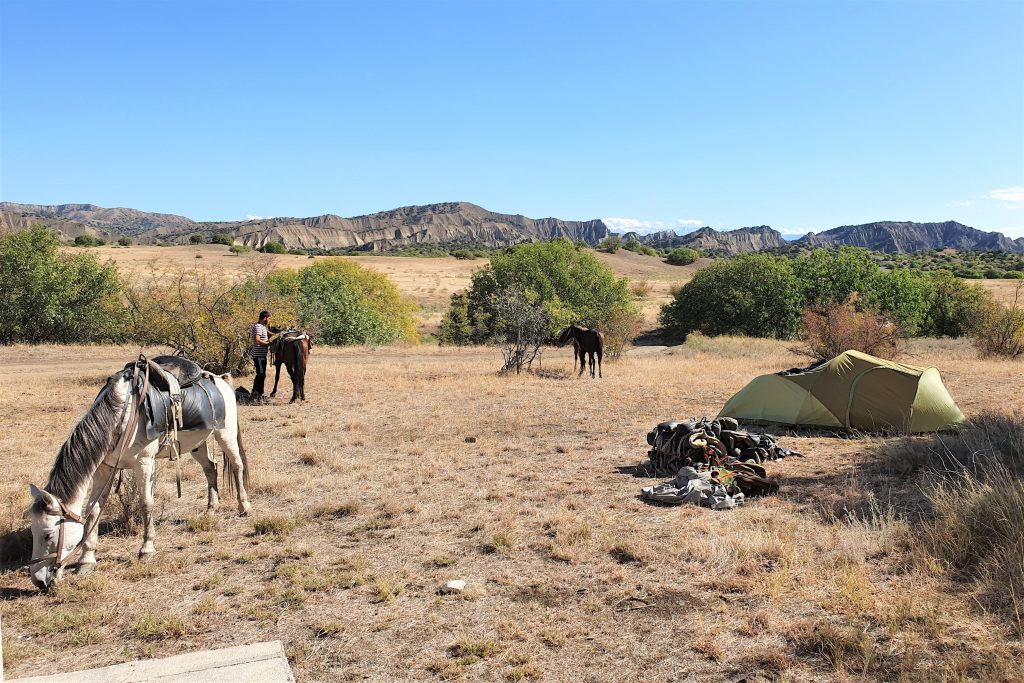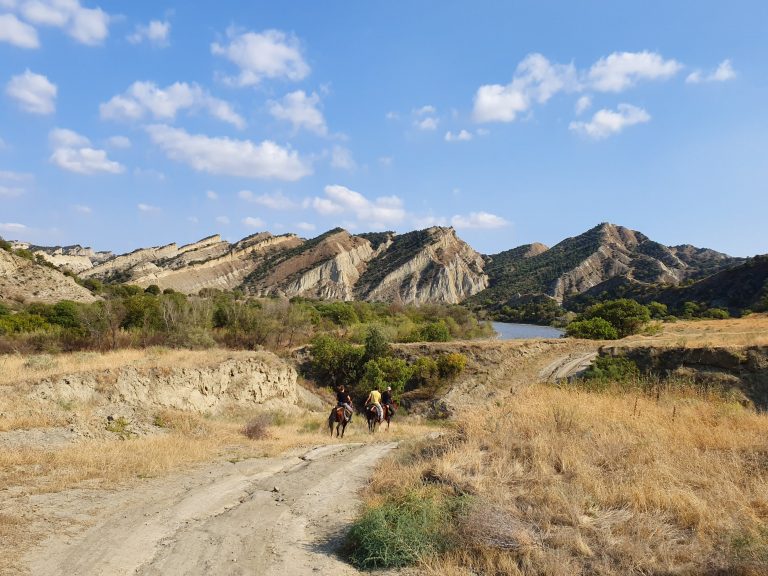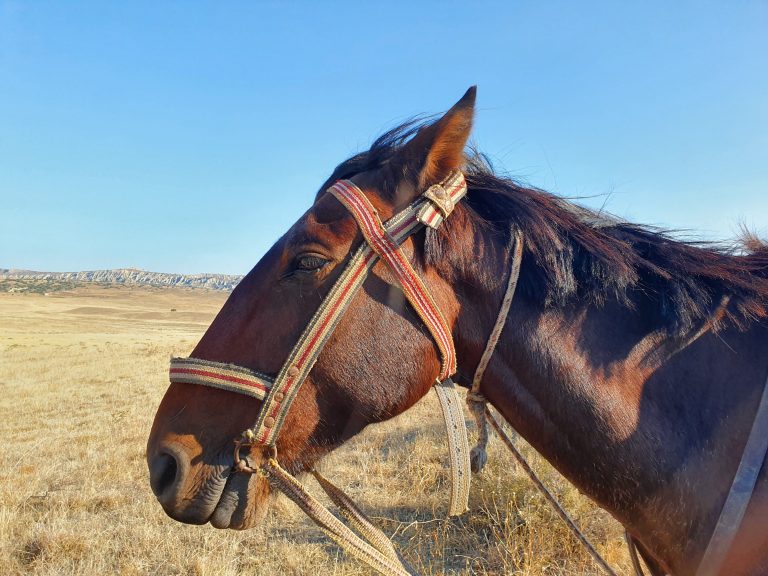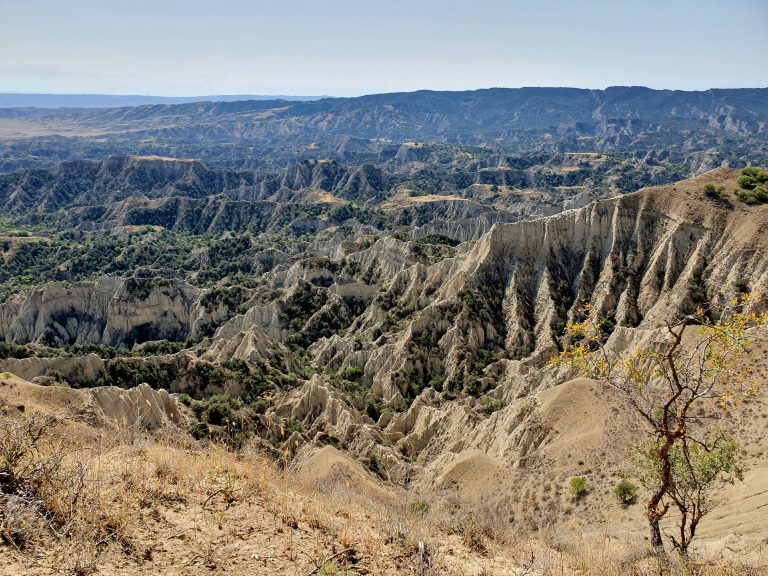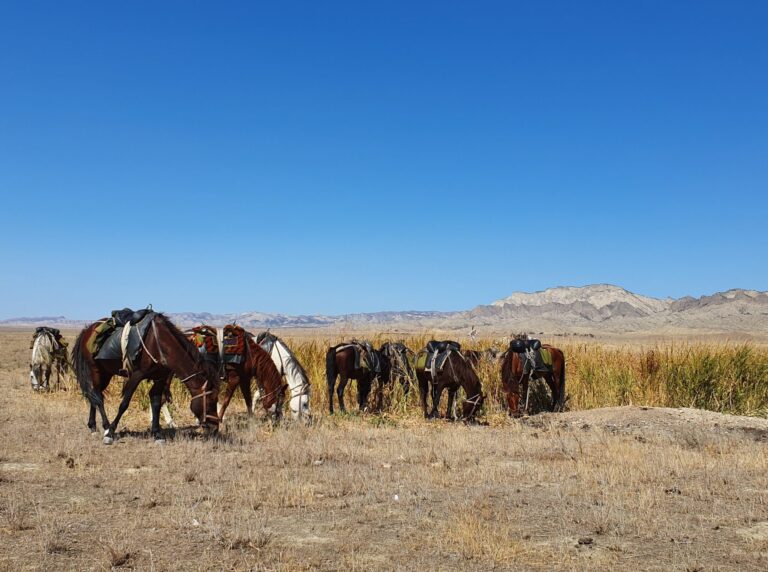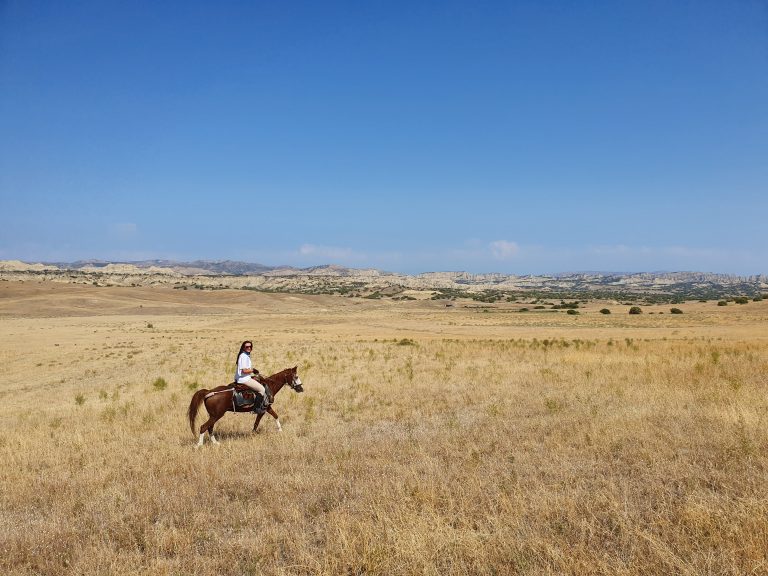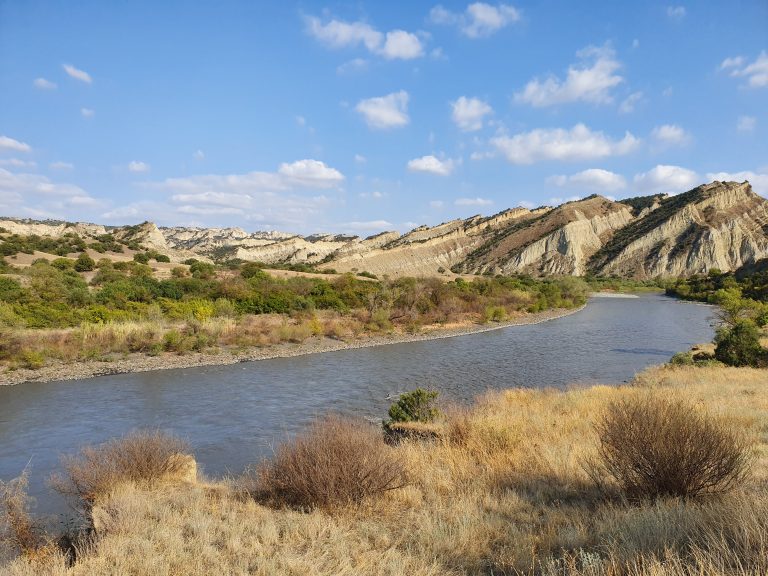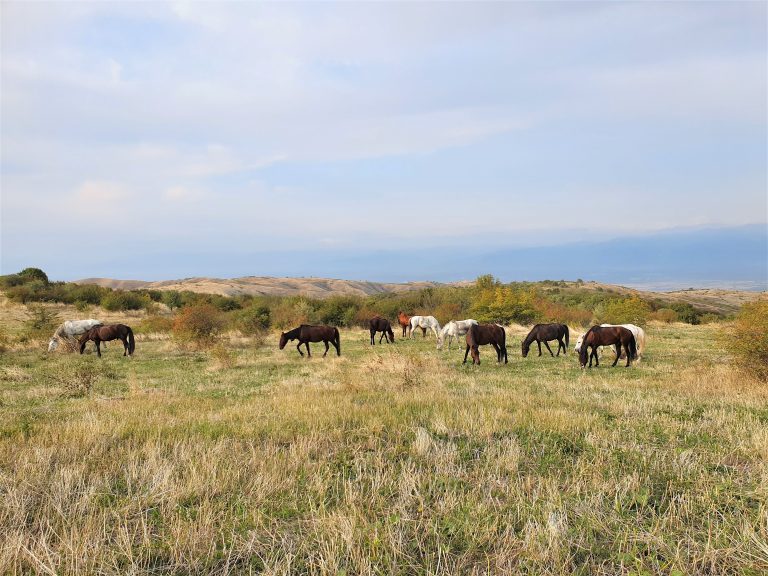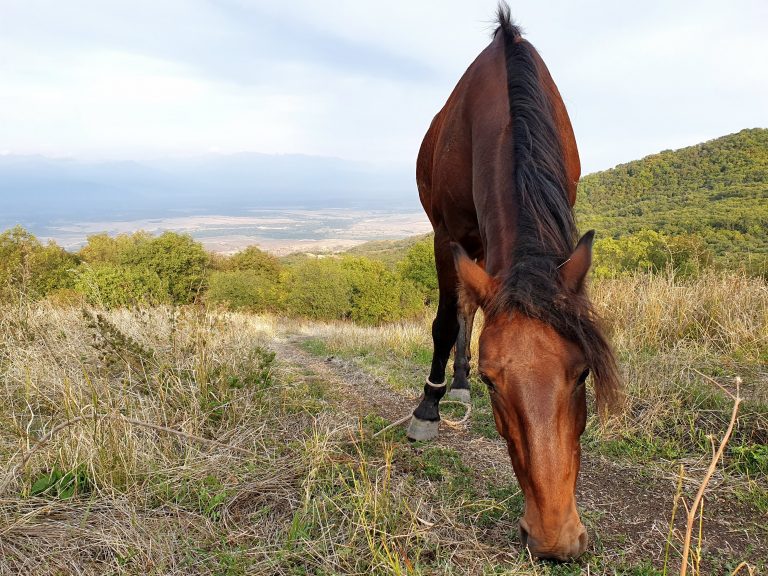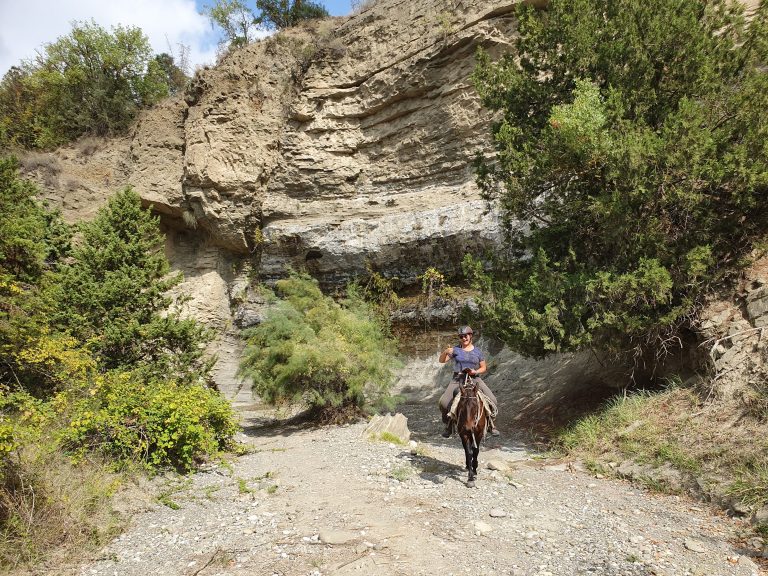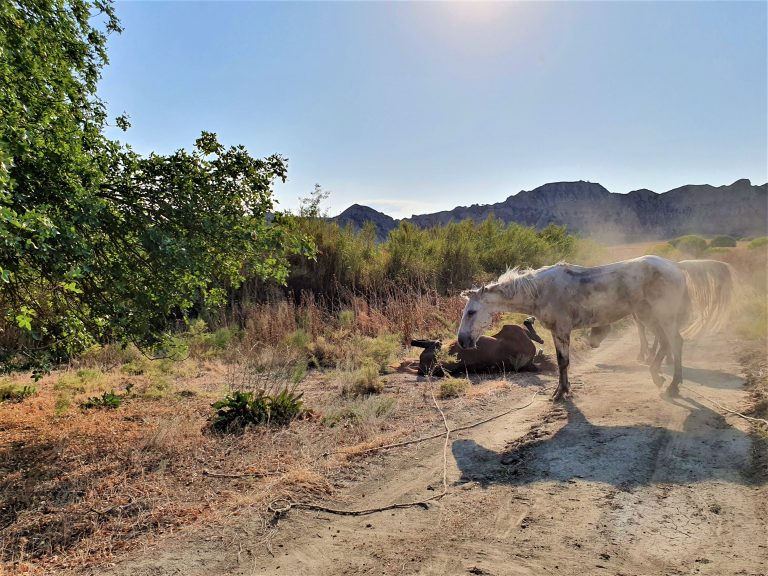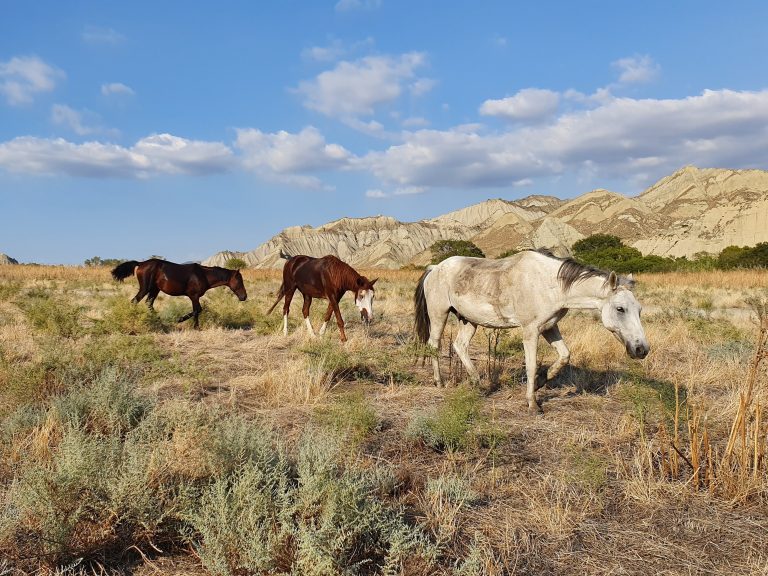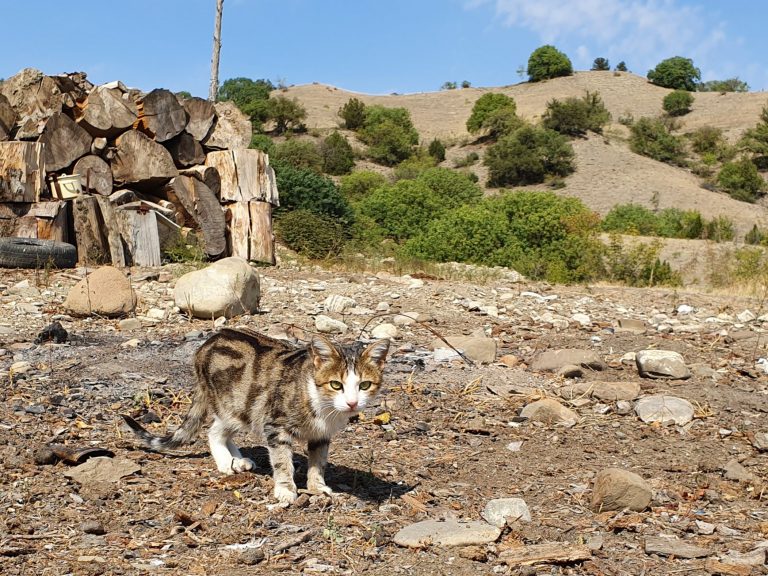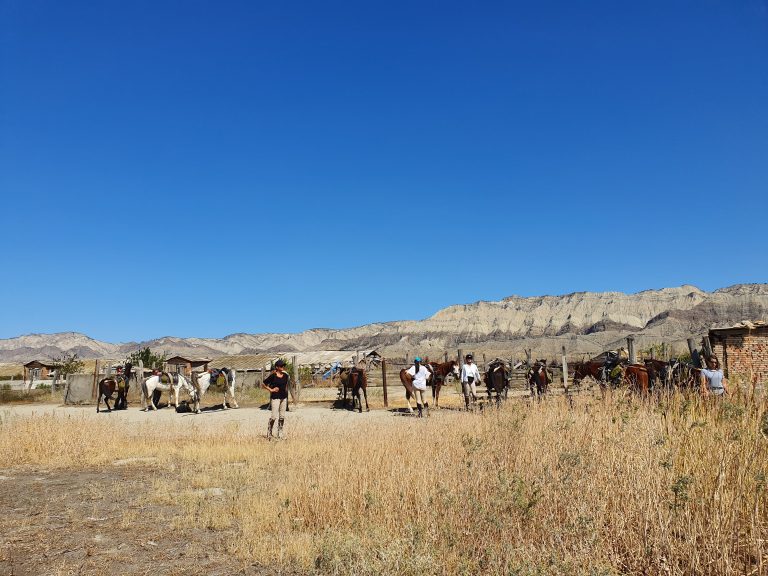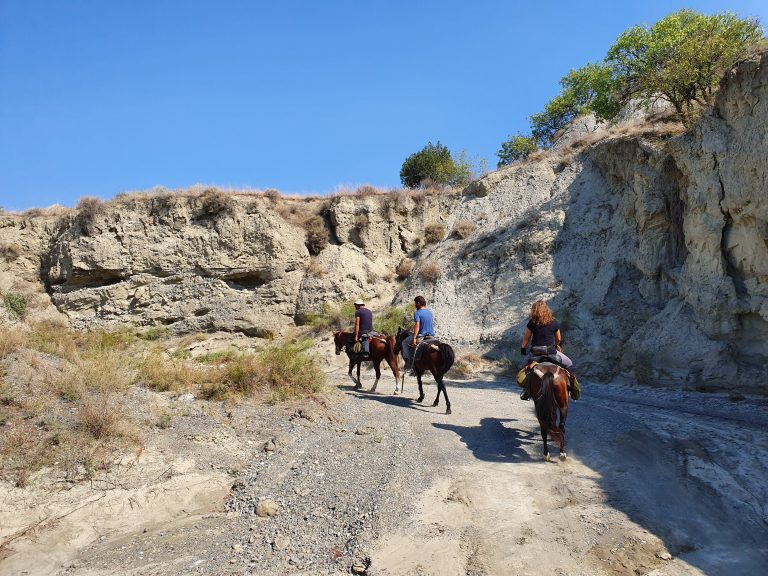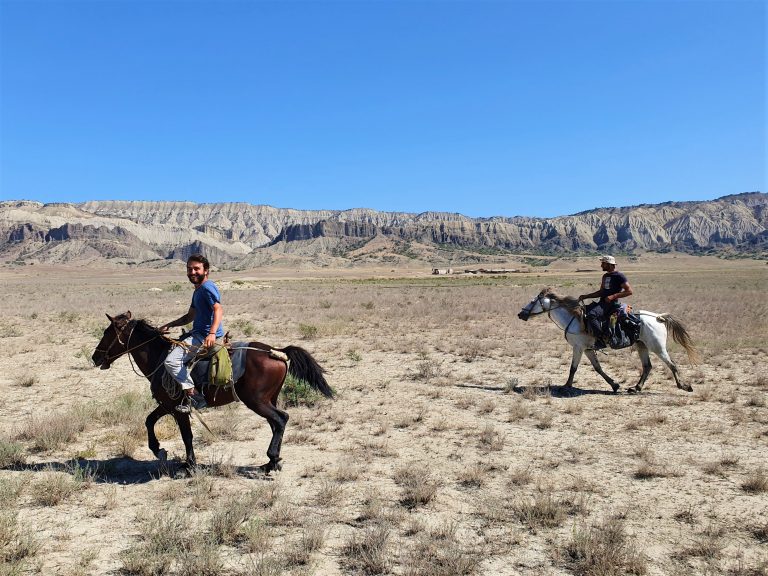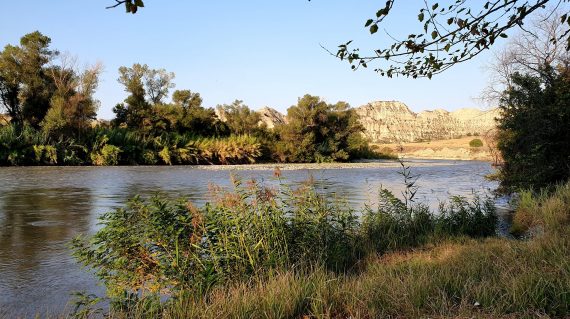
Georgian Savanna 2026
Georgia
The Vashlovani National Park is a unique place on the natural map of Europe. It’s a mix of savanna, semi-desert, steppe and badlands with canyons, cliffs, flood plains and unique vegetation. It’s home to many wild animals, including over a hundred species of birds and many larger animals such as antelopes and… leopards. During days we ride our horses through this amazing, diverse landscape and then spend evenings rising glasses of chacha and wine to Georgian toasts.
-
Days overall9 daysDays in saddle6 days
-
Group size12Available
-
Standardwildlands and nature (mostly camping, in sleeping bags, improvised showers)Luggageno limit kgFoodlocal cuisine, vegetarian available
-
Skillswalk, trot, canter, gallop
The landscape of the Vashlovani National Park in South-Eastern Georgia strongly resembles African savannas and semi-deserts. The Caucasus mountains often appear at the horizon, but Vashlovani is relatively flat, with diverse landscape, open land as well as cliffy canyons aand small mountains. Most areas of this national park are uninhabited by humans, have rarely or never been settled by humans. They remain wild, with large parts of them being protected areas, nature reserves and breeding and nesting grounds.
The only spots with access to any infrastructure are shepherds’ huts, eight Park Ranger’s stations and one Border Police post, as the park is located at the Georgia’s border zone with Azerbaijan. Some of the outer layers of the park become seasonal, Winter pastures for thousands of animals and temporary homes to shepherds tending to herds of sheep, cows and, of course, horses. In mid-Spring shepherds leave Vashlovani and drive their herds to Summer pastures in Tusheti. The park becomes nearly completely uninhabited by humans, apart from a handful of Park Rangers and Georgian Border Police.
Vashlovani in Spring, with the life-giving water of the Alazani river, becomes a green, blooming, busy place with wild life of all sorts, sizes and shapes. It also becomes… a fantastic place for horse riding. In Summer the area becomes too hot for humans and domesticated animals. The park buzzes with half-hidden life through the hottest season, when temperatures often reach and go over 40 degrees Celsius. Until late Summer the park will be drying out to become a beautiful savanna in Autumn. In October shepherds will be back with their flocks and so are we. They will stay in Vashlovani through Winter and part of Spring until they go to mountain pastures again and we are going to ride and visit them.
We ride our trails through Vashlovani in both Spring and Autumn. Depending on the season much of the park’s landscape changes a lot, often transforming vegetation, entire areas, surrounding, scenery and landscape. Both seasons are great to ride and depending on the time of the year you will experience a very different Vashlovani National Park.
The trail is quite diverse in terms of both landscape and riding pace and style. The view between our brave horses’ ears shifts and changes while we ride deeper into Vashlovani. Sometimes the group rides slowly through winding canyonons and dry seasonal riverbeds just to reach open, large swaths of flat lands. There we can canter/gallop just a few meters from the state border line between Georgia and Azerbaijan. Then we will climb hills to amaze at unusual panoramas of seemingly empty areas and follow Alazani river, the source of water for all life in the national park. The only spots where people stay are shepheding huts, Park Ranger’s posts and a Border Police post. Otherwise we ride through Georgian Badlands.
We spend 6 days exploring this beautiful region on local Tushetian horses, a relatively small-framed, brave, tough and smart saddle horses that have been with Tushi highlanders since… forever. Their perfect balance, easy temper, endurance and experience makes them great horses for a diverse trail while they still enjoy racing on long, dusty trails in Vashlovani.
Our Georgian team consists of highlanders, some of them nearly literally raised in the saddle. Their love for horses and andventures combined with experience in trail riding and famous Georgian hospitality makes them the best people for the adventure ahead. During the Vashlovani trail riders are assisted by a 4×4 car and additional team to transport all luggage and camp equipment, set up camps, provide meals and drinks, water for cooking and washing and assist.
During our journey on horses we spend all nights camping at Park Rangers’ sites, mostly in tents, with – ocassionally – available, simple bungalows. At some Ranger stations basic, simple toilets and showers might be available, although it depends on the spot and current conditions. The team will set up improvised shower tents and provide camping shower bags with water.
- 2 nights at a hotel in Tbilisi Tbilisi
- 1 night at a hostel on the outskirts of Vashlovani
- 5 nights tenting in Vashlovani (or some nights in bungalows – if accessible), tents provided
- Breakfasts in Tbilisi (one or two, depending on departure time flight)
- Two dinners at a restaurant in Tbilisi (first and penultimate evening)
- All meals in Vashlovani (brakfasts, lunches “to go”, dinners)
- Transfers to and from Tbilisi airport (on first and last days of the tour)
- Transport from Tbilisi to Vashlovani and back
- Horsemen and guides during the entire ride in Vashlovani
- English-speaking pilot during the entire tour
- Horse with full tack and equipment
- Tents and mats for the entire duration of the ride in Vashlovani
- 4×4 car support in Vashlovani
- Tourist insurance covering high-risk sports
- Flight tickets to and from Georgia
- Minor personal expenses (souvenirs, additional snacks, admission tickets, etc.)
- Optional: single room supplement (where available)
- Day 1 Welcome to Georgia
- Day 2 Outskirts of Vashlovani
- Day 3 Black Mountain
- Day 4 Across Alazani Valley
- Day 5 Canyons
- Day 6 Leopards' hunting grounds
- Day 7 Winter pastures
- Day 8 Last look at Vashlovani
- Day 9 Farewell to Georgia

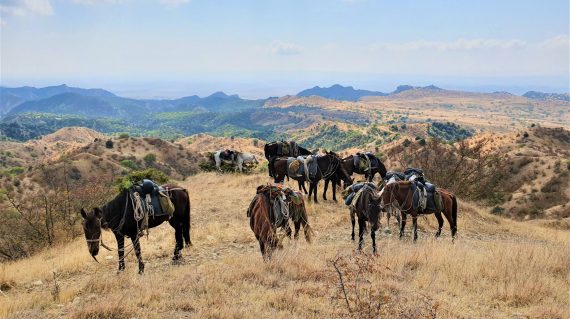
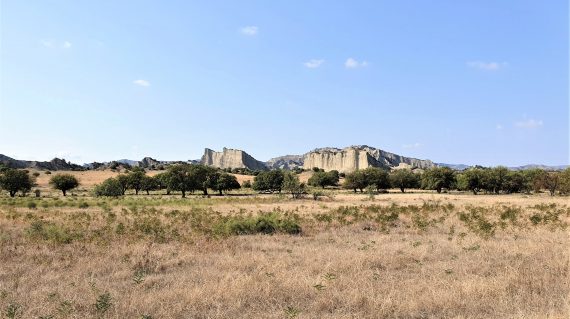
In Tbilisi, the group stays at a European standard family hotel, in double and triple rooms. Before entering the park we stay at a local hostel, quite new and relatively comfy. During the proper ride in Vashlovani we spend all nights at Park Rangers’ stations, camping and tenting. In some of them small bungalows might be available, although it depends in a number of factors. If available – we will spend a night or two inside them. In general we camp and tent in 2-person tents, so a sleeping bag is essential. At camp sites we usually have access to running water, although not always hot, and electricity. Upon request, for those who’d like an additional, single-person tents, these can be rented on the spot (around 200 GEL for 5 days).
In Tbilisi, we eat breakfasts on the second and last day (depending on the time of your departure flight) at the hotel. For two dinners, on the first and penultimate day, we go to one of our favourite restaurants serving excellent Georgian cuisine. During the proper horse trail in Vashlovani our team prepares meals for the group. For daily parts of the trail riders are provided with to-go meals that we eat during lunch breaks on the way.
Most meals are traditional dishes, typical Georgian cuisine and shepherd food: mainly vegetables, mutton and local cheese of various sorts. Drinks – apart from crystal clear water – are herbal infusions, wine, and chacha (local moonshine). In Tbilisi, regular restaurants are common, serving all kinds of dishes.
Equipment
We use typical Caucasian saddles. They are quite different from the classical-English and Western-style saddles and very comfortable for both horses and riders. Steel saddle bows are set on wooden benches. This construction is covered with a build-in pad and a moderately soft “pillow” made of leather. The pillow is kept in place by a strap, usually made of leather, which serves as a girth at the same time. Tail docks are commonly used.
Stirrup leathers in Georgia are quite short – Georgians practice a distinctive seat: legs in the front, knees high. Stirrups are quite simple and wide, allowing trekking shoes to fit inside well. Bridles are also simple, made the usual way. We use bits.
Caucasian / Georgian moutain saddles often raise interest. Fairly unknown in the West these saddles are very comfortable for long and steep rides. Pommels and cantles are quite high to stabilize riders in mountainous terrain and the pillow seat absorbs bumps very well. This non-standard construction is also quite practical when it comes to attaching larger quantities of luggage.
What you should take with you
The trail leads through vastly uninhabited national park and nature reserve, but all our belongings and equipment are transported by an assisting 4×4 car. While in saddles we take only what we need for the day plus documents, as the entire park is a border zone. We provide small saddlebags for everything you might need during the day.
- passport
- cash, USD or EUR
- electronic devices, e.g. camera
- sleeping bag
- a handy backpack or hip bag (for documents, phone, etc.)
- a canteen or other water containers (or simply: an empty plastic bottle to refill)
- flashlight; head flashlights are quite handy
- sunscreen
- insect repellent
- head cover against the sun
- trekking shoes, better suited for this environment compared to classical jodhpur/riding boots
- raincoat / waterproof jacket
- flip-flops for showering
| Date | Trip Status | Price | Spots | |
|---|---|---|---|---|
30 April 2026 - 8 May 2026
|
Available, English-speaking guide/pilot |
1390 € |
12 |
|
15 May 2026 - 23 May 2026
|
Full group, English-speaking guide/pilot |
1390 € |
0 |
|
22 October 2026 - 30 October 2026
|
Available, English-speaking guide/pilot |
1390 € |
12 |
